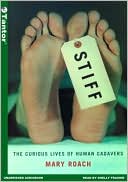Stiff: The Curious Lives of Human Cadavers
Search in google:
An oddly compelling, often hilarious exploration of the strange lives of our bodies postmortem.For 2,000 years, cadavers---some willingly, some unwittingly---have been involved in science's boldest strides and weirdest undertakings. They've tested France's first guillotines, ridden the NASA Space Shuttle, been crucified in a Parisian laboratory to test the authenticity of the Shroud of Turin, and helped solve the mystery of TWA Flight 800. For every new surgical procedure---from heart transplants to gender reassignment surgery---cadavers have been there alongside surgeons, making history in their quiet way.In this fascinating, ennobling account, Mary Roach visits the good deeds of cadavers over the centuries---from the anatomy labs and human-sourced pharmacies of medieval and nineteenth-century Europe to a human decay research facility in Tennessee, to a plastic surgery practice lab, to a Scandinavian funeral directors' conference on human composting. In her droll,... The New Yorker In the twelfth century, the bazaars of Arabia were known to offer an exotic and allegedly salutary concoction called "mellified man" -- essentially human remains steeped in honey. Mellified man was also known as "human mummy confection," and one recipe for it called specifically for "a young, lusty man" as the main ingredient. This strange footnote in the history of death and decay is recalled by Mary Roach in her surprisingly lively Stiff: The Curious Lives of Human Cadavers. "Cadavers," Roach writes, "are our superheroes: They brave fire without flinching, withstand falls from tall buildings and head-on car crashes into walls. "We learn, among other notable macabre facts, that a detached human head is about the size and weight of a roaster chicken, that King Ptolemy I of Egypt first green-lighted autopsies in 300 B.C., that embalming-fluid companies once sponsored best-preserved-body contests, and that the French at the time of the Revolution were obsessed with discovering how long guillotined heads remained aware of their surroundings. Roach reports that the next big thing on the mortuary horizon is something called the "tissue digestor," which replaces the outmoded options of burial or cremation with, essentially, a big tub of lye. In Rest in Peace, the historian Gary Laderman looks into the culture of funeral homes in America, noting that embalming took off after the Lincoln assassination and became a booming business in the twentieth century, nudged along by the popularity of mummy films and a burgeoning class of undertakers leafing through Casket & Sunnyside magazine. As Roach puts it: "Death. It doesn't have to be boring." (Mark Rozzo)
Introduction91A Head is a Terrible Thing to Waste: Practicing surgery on the dead192Crimes of Anatomy: Body snatching and other sordid tales from the dawn of human dissection373Life After Death: On human decay and what can be done about it614Dead Man Driving: Human crash test dummies and the ghastly, necessary science of impact tolerance875Beyond the Black Box: When the bodies of the passengers must tell the story of a crash1136The Cadaver Who Joined the Army: The sticky ethics of bullets and bombs1317Holy Cadaver: The crucifixion experiments1578How to Know if You're Dead: Beating-heart cadavers, live burial, and the scientific search for the soul1679Just a Head: Decapitation, reanimation, and the human head transplant19910Eat Me: Medicinal cannibalism and the case of the human dumplings22111Out of the Fire, into the Compost Bin: And other new ways to end up25112Remains of the Author: Will she or won't she?281Acknowledgments293Bibliography295








